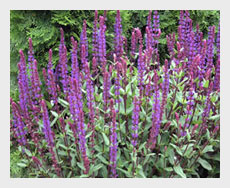 Žalfija ili kadulja, na latinskom Salvia officinalis i njena lekovita svojstva poznati su još od antičkog doba. Kasnije su je svi manastiri gajili jer je važila za jednu od najlekovitijih biljaka. Sve navedeno dokazuje i sam njen latinski naziv koji datira iz rimskog doba, odnosno pojam Salvia potiče od glagola salvare što na latinskom znači spasavati, spasiti. Može se naći u navodima skoro svih antičkih medicinskih pisaca ali i u analima vojskovođa i kraljeva. Od žalfije koriste se isključivo list koji se bere u fazi cvetanja u maju mesecu. List ove bilje sadrži preko 2 posto eteričnog ulja (ima dejstvo antiseptika) koje čini esenciju pozitivnog dejstva ove biljke, mada ona sadrži i vitamin A, gvožđe, kalcijum i u tragovima druga važna jedinjenja. List žalfije se u narodnoj medicini koristi za lečenje upala ždrela, promuklosti, jačanje organizma, prehlada, gripa itd.
Žalfija ili kadulja, na latinskom Salvia officinalis i njena lekovita svojstva poznati su još od antičkog doba. Kasnije su je svi manastiri gajili jer je važila za jednu od najlekovitijih biljaka. Sve navedeno dokazuje i sam njen latinski naziv koji datira iz rimskog doba, odnosno pojam Salvia potiče od glagola salvare što na latinskom znači spasavati, spasiti. Može se naći u navodima skoro svih antičkih medicinskih pisaca ali i u analima vojskovođa i kraljeva. Od žalfije koriste se isključivo list koji se bere u fazi cvetanja u maju mesecu. List ove bilje sadrži preko 2 posto eteričnog ulja (ima dejstvo antiseptika) koje čini esenciju pozitivnog dejstva ove biljke, mada ona sadrži i vitamin A, gvožđe, kalcijum i u tragovima druga važna jedinjenja. List žalfije se u narodnoj medicini koristi za lečenje upala ždrela, promuklosti, jačanje organizma, prehlada, gripa itd.
